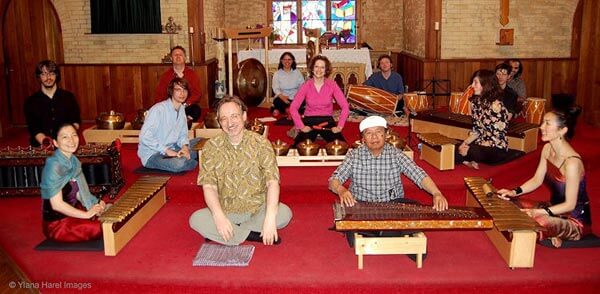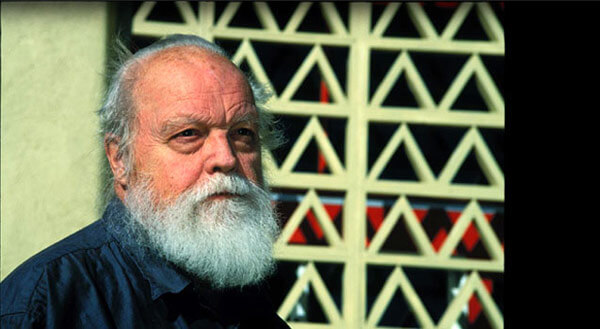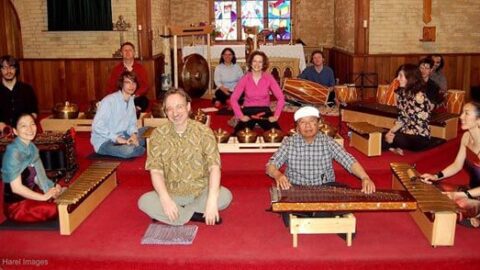 Esprit Orchestra’s second concert of the season, held Sunday November 17, 2013, at Koerner Hall, Royal Conservatory of Music Toronto, was an extended homage to gamelan music. Of particular interest to the night’s thematic program, O Gamelan, were the sounds, moods and techniques of traditional Indonesian (specifically Balinese, Sundanese, and Javanese) culture, in both music and dance, as interpreted through the lens of new music. Toronto’s very own Evergreen Club Contemporary Gamelan joined Esprit Orchestra on stage for a large portion of the concert, while Balinese dancer Putu Evie Suyadnyani dazzled with a special solo performance of Legong Condong.
Esprit Orchestra’s second concert of the season, held Sunday November 17, 2013, at Koerner Hall, Royal Conservatory of Music Toronto, was an extended homage to gamelan music. Of particular interest to the night’s thematic program, O Gamelan, were the sounds, moods and techniques of traditional Indonesian (specifically Balinese, Sundanese, and Javanese) culture, in both music and dance, as interpreted through the lens of new music. Toronto’s very own Evergreen Club Contemporary Gamelan joined Esprit Orchestra on stage for a large portion of the concert, while Balinese dancer Putu Evie Suyadnyani dazzled with a special solo performance of Legong Condong.

The night began with Echo Spirit Isle (1983), a piece by Esprit music director and conductor Alex Pauk. Inspired by a book about an imagined Indonesian island – Gifts of Unknown Things, by Lyall Watson – Pauk’s work similarly evoked images of nature, physics, and the supernatural in a fantasia of shimmering yet subtly tenacious rhythmic textures. Echo was originally written for gamelan, but its basic musical elements were extracted and turned into a work for large orchestra, as demonstrated in this performance. The result was a piece which thoughtfully engaged the imagination, as any good book would do, instead of presenting gamelan music in a straight forward manner.
Chan Ka Nin’s Èveil aux Oiseaux (2005), which translates as “The Awakening of the Birds”, followed in a similar vein by creating a sonic atmosphere around the idea of nature. This piece featured Evergreen Gamelan playing in tandem with eleven members of Esprit, where the qualities in timbre of one set of instruments were often pitched against the other. As such, Chan’s work presented a unique musical contrast between sharpness versus roundness and serenity versus clamour, drawing from the composer’s experience as a young child growing up in Hong Kong.

Evergreen’s feature performance for the evening was Lou Harrison’s Threnody for Carlos Chavez (1978), written for viola and Sundanese gamelan, also known as Gamelan degung. This was by far the most intimate and meditative work in the program, as Douglas Perry’s viola lilted and swayed to the soulful, contemplative resonance of the gamelan. What stood out in particular was the usage of simple triple-meter motifs, instead of the duple meter rhythmic stylings of traditional gamelan music, a practice which Harrison adapted from Western medieval music.
José Evangelista’s namesake piece, O Gamelan (2013), was commissioned for this specific occasion: to celebrate the rich cultural context from which gamelan music emerged. In the program notes, Evangelista described gamelan as something that “remains a goal that I’ll never attain”; O Gamelan in a way reflected this feeling of futility as there lacked a certain direction to the piece. The composition, however, was redeemed by the richness in detail with contributions from instruments throughout the orchestra, including none other than the sounds of a steel drum.
André Ristic’s Projet “Peuple” (2005) for gamelan and ensemble introduced the audience to his musical blueprint of society (as a social construct) in its various forms and functions. The gamelan and woodwinds were characterized as two divisive parties unable to communicate or get along. Under the tutelage of the double bass (here taking an unlikely leading role, though not easily heard above other instruments), however, the two separate music worlds learn slowly to collaborate. As things fell into place, the bass launched into a feverish cadenza-like passage as if to imitate the rant of an egomaniacal leader, though a rather soft spoken one. Oddly enough, the schismatic nature of Projet “Peuple” was what made the piece feel complete.
Last of the night was Claude Vivier’s Pulau Dewata (1977). On paper, this piece is a single line of music which can be arranged for any combination of instruments as seen suitable. Esprit’s performance was arranged by Scott Good, rendering Pulau into a full and surprisingly muscular orchestration, though the piece failed to leave much of an impression as a follow-up to the rest of the program. On the whole, O Gamelan was certainly an ambitious and exploratory concert, but it featured much less gamelan than expected of an event with such a declarative title. Here’s to hoping that Esprit will commission more gamelan-centric works in the future, as the wondrous sounds of these percussive instruments are more than worthy of being heard by wider audiences, in new music and beyond.
























